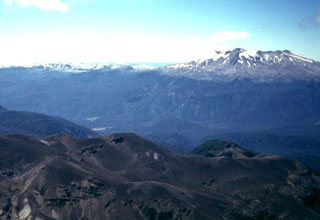Report on Puyehue-Cordon Caulle (Chile) — 29 June-5 July 2011
Smithsonian Institution / US Geological Survey
Weekly Volcanic Activity Report, 29 June-5 July 2011
Managing Editor: Sally Sennert.
Please cite this report as:
Global Volcanism Program, 2011. Report on Puyehue-Cordon Caulle (Chile) (Sennert, S, ed.). Weekly Volcanic Activity Report, 29 June-5 July 2011. Smithsonian Institution and US Geological Survey.
Puyehue-Cordon Caulle
Chile
40.59°S, 72.117°W; summit elev. 2236 m
All times are local (unless otherwise noted)
OVDAS-SERNAGEOMIN reported that the eruption continued from the Cordón Caulle rift zone, part of the Puyehue-Cordón Caulle volcanic complex. During 29-30 June weather conditions prevented views of the eruption plume by cameras installed around the volcano as well as by satellite. On 1 July a white plume, possibly with lower ash content, rose 3 km above the crater and was observed in satellite imagery drifting 200 km N. News articles noted that flights in Argentina were disrupted.
During 2-4 July SERNAGEOMIN noted that dark gray plumes rose 2-4 km above the crater and were detected in satellite imagery drifting 200-900 km NW, N, and somewhat E. Although there were no new aerial observations, seismicity indicated that during 29 June-2 July the lava flow remained active, although to a lesser degree than during previous days. During 2-3 July seismic signals indicated that lava had stopped flowing or was emitted at a slower rate. The next day high-intensity tremor suggested that the lava flow was again active. On 5 July satellite imagery showed that the plume drifted N then NW. The Alert Level remained at 6, Red.
Geological Summary. The Puyehue-Cordón Caulle volcanic complex (PCCVC) is a large NW-SE-trending late-Pleistocene to Holocene basaltic-to-rhyolitic transverse volcanic chain SE of Lago Ranco. The 1799-m-high Pleistocene Cordillera Nevada caldera lies at the NW end, separated from Puyehue stratovolcano at the SE end by the Cordón Caulle fissure complex. The Pleistocene Mencheca volcano with Holocene flank cones lies NE of Puyehue. The basaltic-to-rhyolitic Puyehue volcano is the most geochemically diverse of the PCCVC. The flat-topped, 2236-m-high volcano was constructed above a 5-km-wide caldera and is capped by a 2.4-km-wide Holocene summit caldera. Lava flows and domes of mostly rhyolitic composition are found on the E flank. Historical eruptions originally attributed to Puyehue, including major eruptions in 1921-22 and 1960, are now known to be from the Cordón Caulle rift zone. The Cordón Caulle geothermal area, occupying a 6 x 13 km wide volcano-tectonic depression, is the largest active geothermal area of the southern Andes volcanic zone.
Sources: Servicio Nacional de Geología y Minería (SERNAGEOMIN), Agence France-Presse (AFP)

